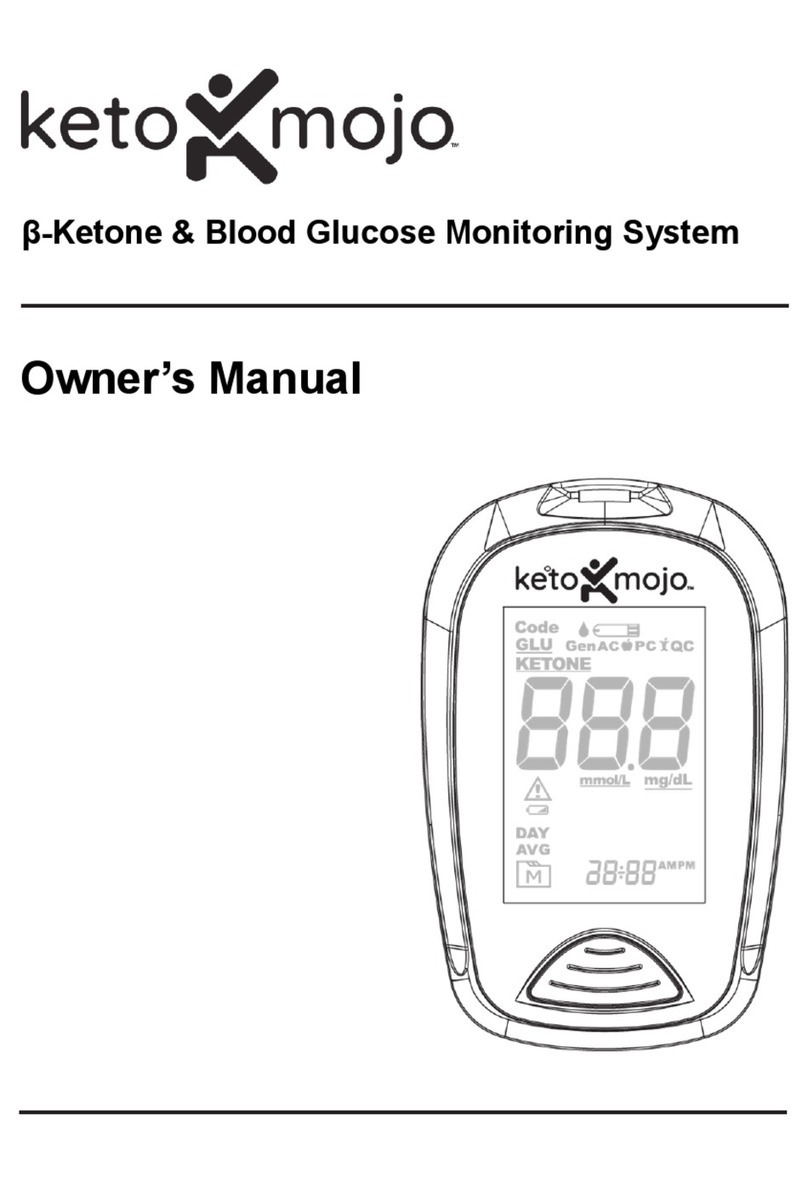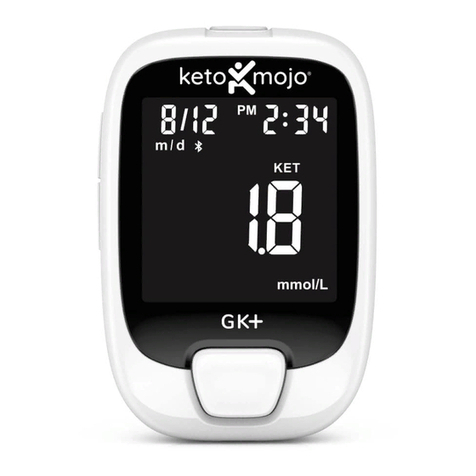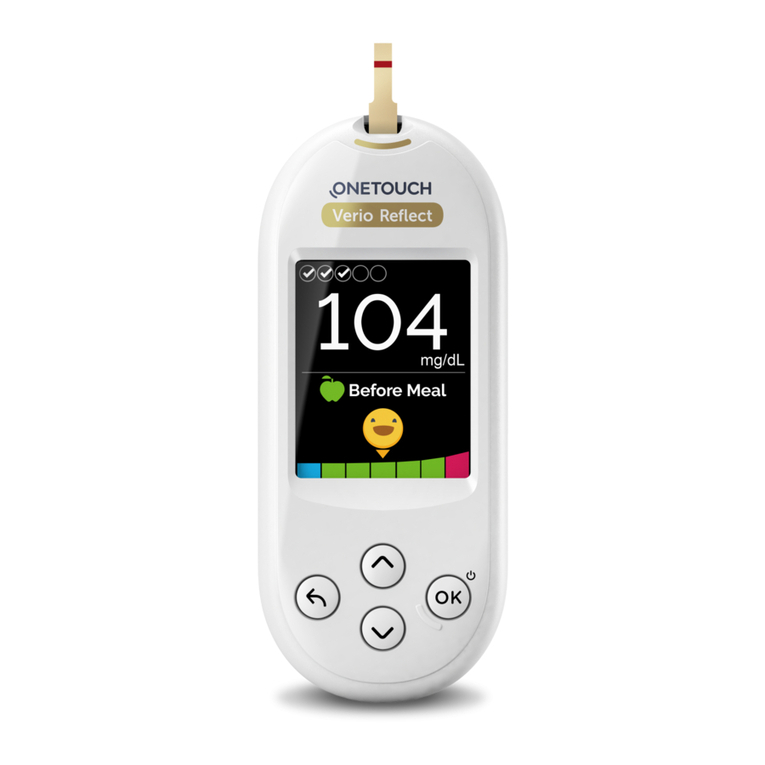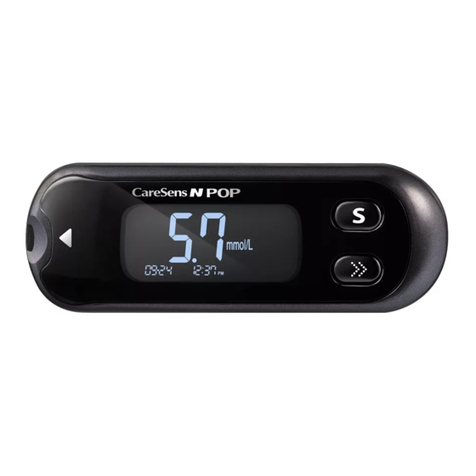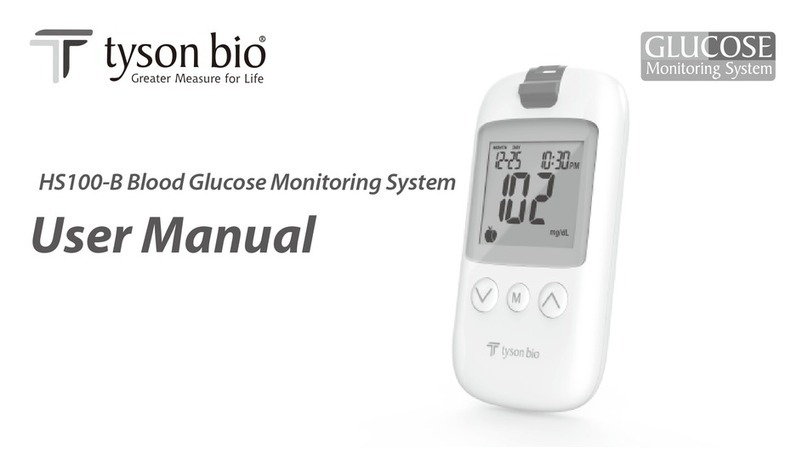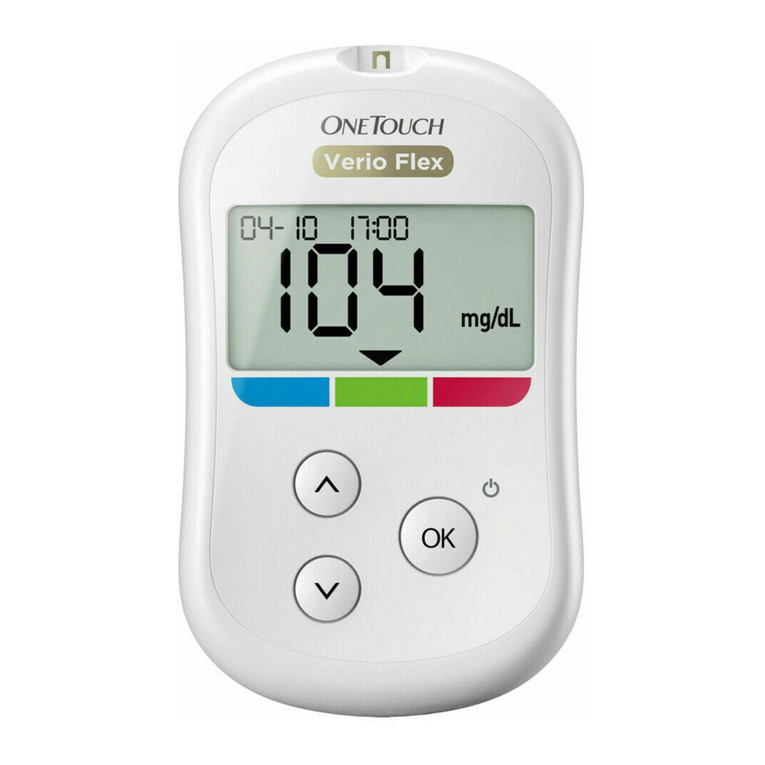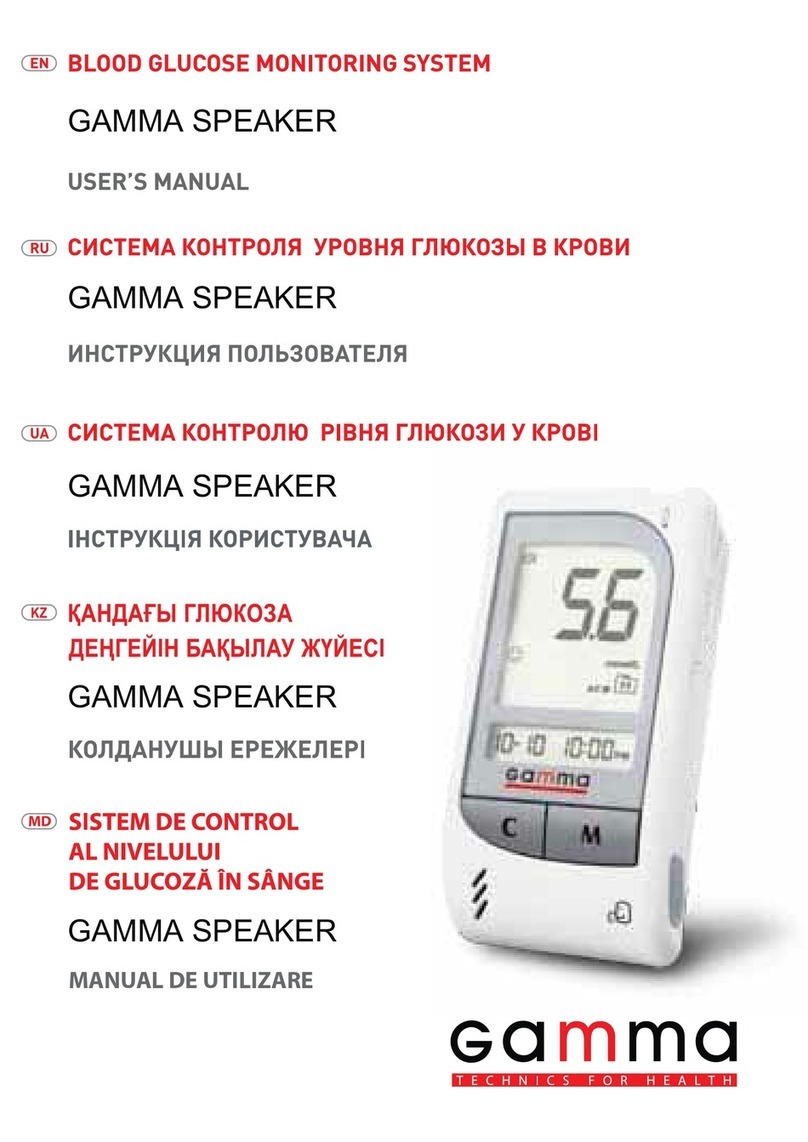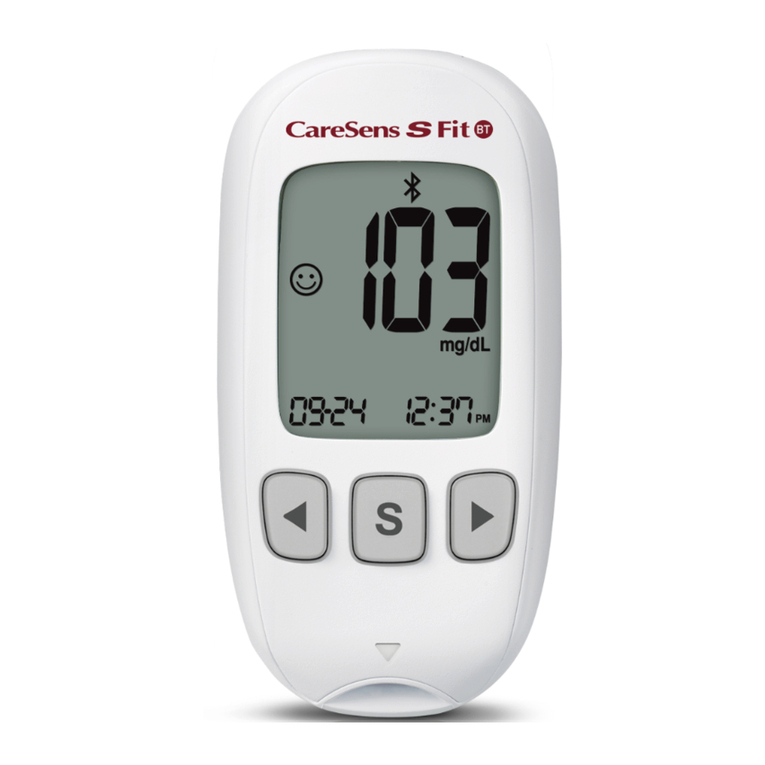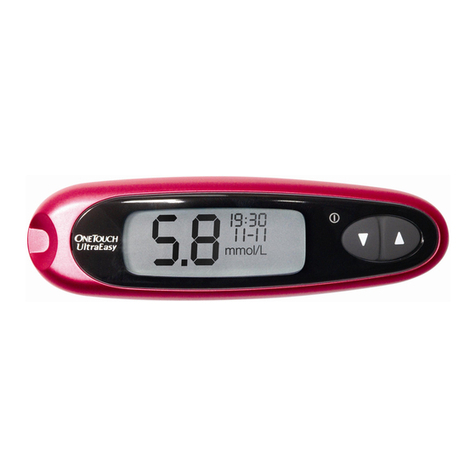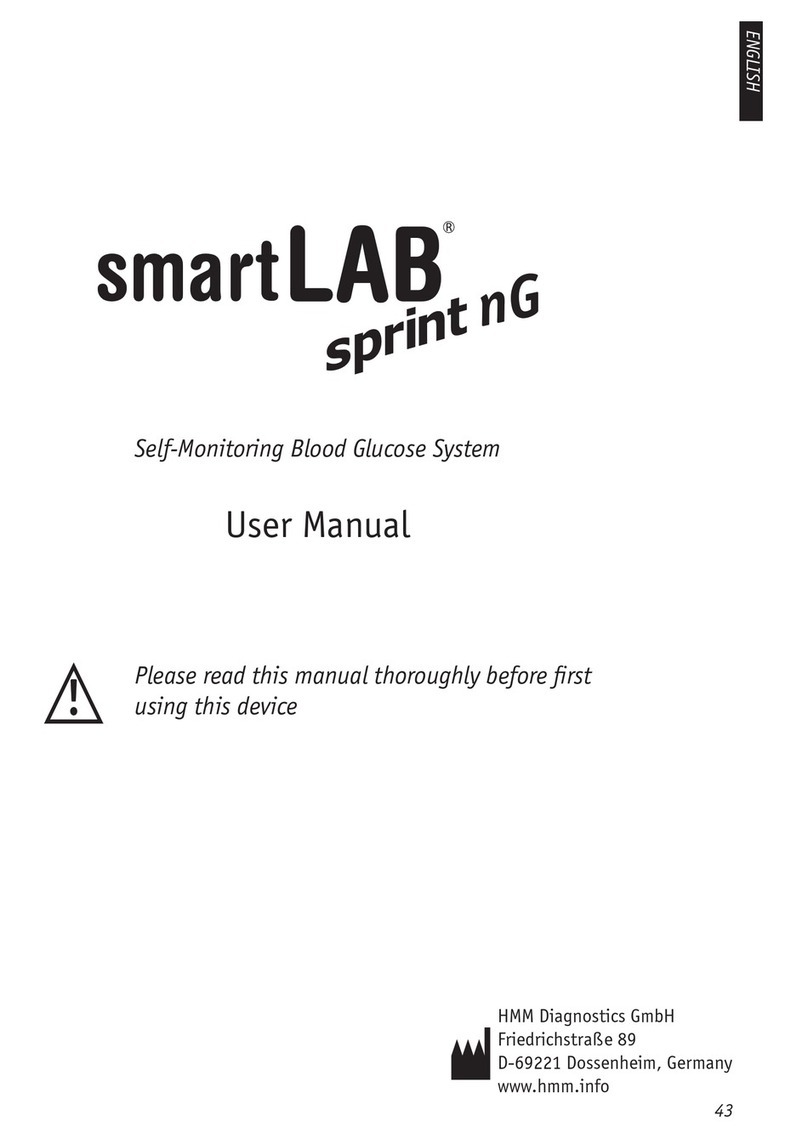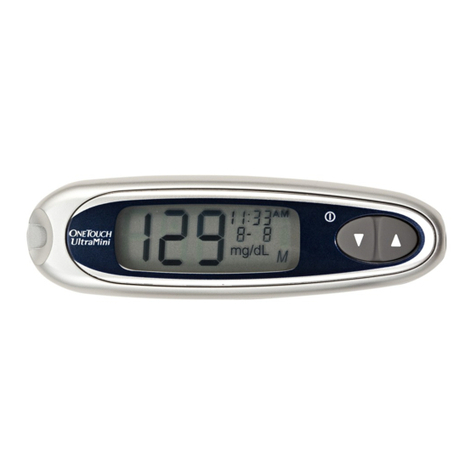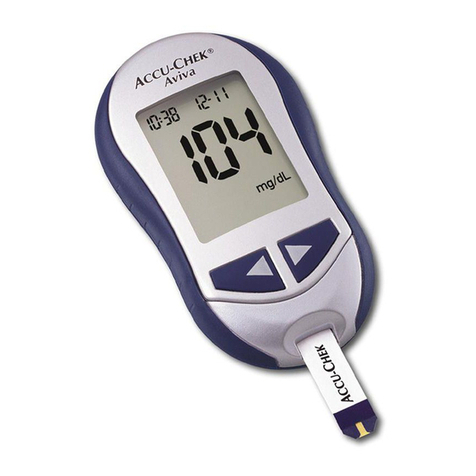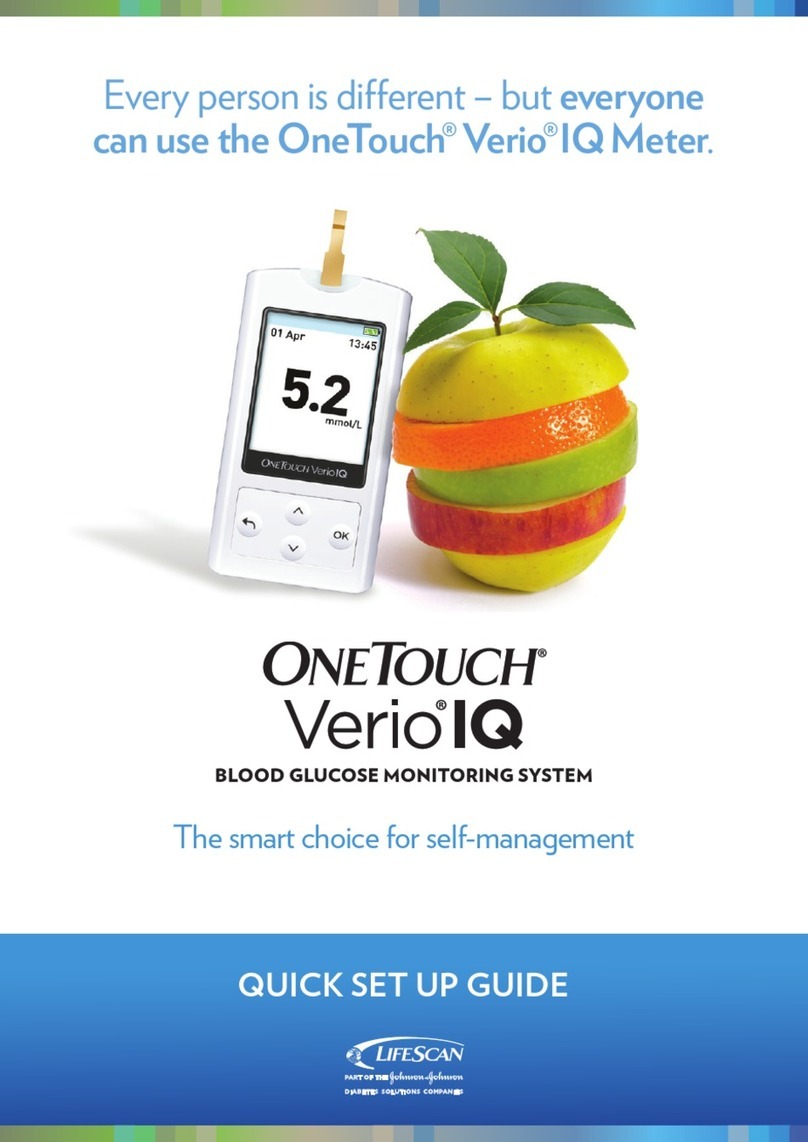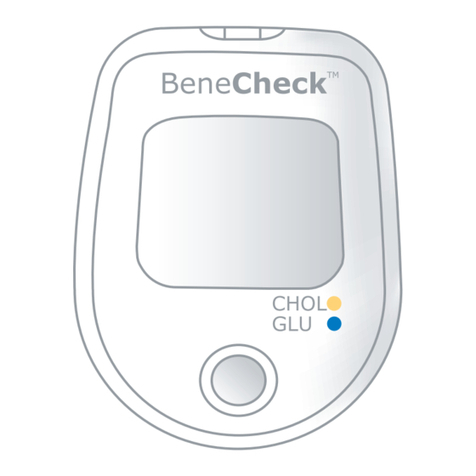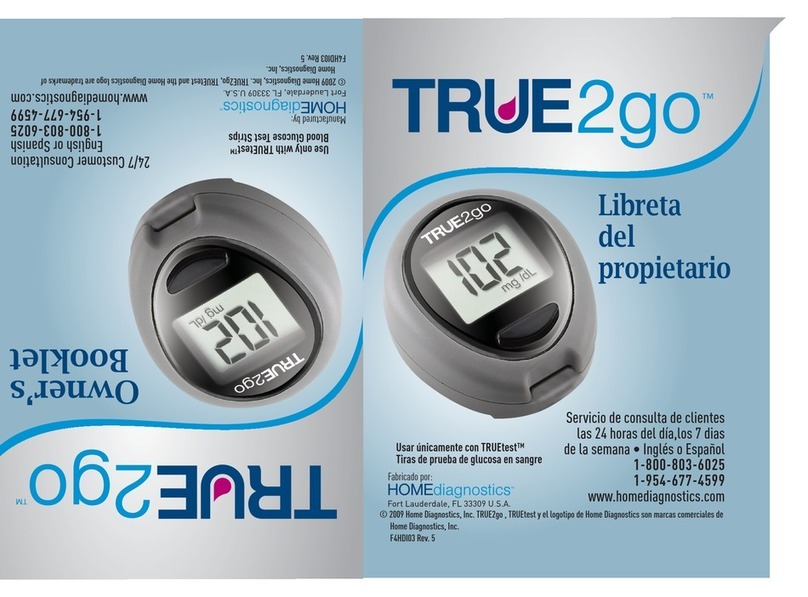Keto-Mojo TD-4279 User manual

Owner’s Manual
β-Ketone & Blood Glucose
Monitoring System
TD-4279


3
Dear TD-4279 keto-mojo System Owner:
Thank you for purchasing the TD-4279 β-Ketone & Blood Glucose
Monitoring System. This manual provides important information to help
you to use the system properly. Before using this product, please read
the following contents thoroughly and carefully.
The System measures both blood glucose and β-ketone. Regular
monitoring of your blood glucose and β-ketone levels can help you and
your doctor gain better control of your diabetes. Due to its compact
size and easy operation, you can use the TD-4279 β-Ketone & Blood
Glucose Monitoring System to easily monitor your blood glucose and
β-ketone levels by yourself anywhere, any time.
If you have other questions regarding this product, please contact KETO-
CHECK at 800.513.1965 (10am - 4pm PST) or place of purchase.
Intended Use
The keto-mojo β-ketone & blood glucose monitoring system is
intended for the quantitative measurement of glucose in fresh capillary
whole blood from the finger, and for the quantitative measurement of
β-ketone (beta-hydroxybutyrate) in fresh capillary whole blood from
the finger. The system is intended for in vitro diagnostic use and
for single-patient use as an aid to monitoring the effectiveness of a
diabetes control program. The system should not be used for the
diagnosis of or screening for diabetes, nor for use on neonates.
The test for haematocrit (HCT) as part of the system, is intended
for use in the in vitro quantification of packed red blood cell volume
fraction in capillary whole blood as an aid in monitoring the status of
total volume of red blood cells. The test reading of haematocrit (HCT)
is used only to determine whether the blood test sample is within the
acceptable range of β-ketone & blood glucose monitoring system
monitoring system.It should not be used for the diagnosis of anaemia
or erythrocytosis.
Version 1.0 2017/07 311-4279300-014

4
IMPORTANT SAFETY PRECAUTIONS
READ BEFORE USE
1. Use this device ONLY for the intended use described in this manual.
2. Do NOT use accessories which are not specied by the manufacturer.
3. Do NOT use the device if it is not working properly or if it is damaged.
4. Do NOT use the equipment in places where aerosol sprays are being
used, or where oxygen is being administered.
5. Do NOT under any circumstances use the device on neonates or
infants.
6. This device does NOT serve as a cure for any symptoms or diseases.
The data measured is for reference only.
7. Before using this device, read all instructions thoroughly and practice
the test. Carry out all the quality control checks as directed.
8. Keep the device and testing equipment away from young children.
Small items such as the battery cover, batteries, test strips, lancets
and vial caps are choking hazards.
● Themeterandlancingdeviceareforsinglepatientuse.Donotshare
themwithanyoneincludingotherfamilymembers!Donotuseonmultiple
patients!
● Allpartsofthekitareconsideredbiohazardousandcanpotentially
transmitinfectiousdiseases,evenafteryouhaveperformedcleaning
anddisinfection.
Formoreinformation,pleasevisit
1.“FDAPublicHealthNotification:UseofFingerstickDevicesonMorethan
OnePersonPosesRiskforTransmittingBloodbornePathogens:Initial
Communication”(2010)
http://www.fda.gov/MedicalDevices/Safety/AlertsandNotices/ucm224025.
htm
2.“CDCClinicalReminder:UseofFingerstickDevicesonMorethanOne
PersonPosesRiskforTransmittingBloodbornePathogens”(2010)
http://www.cdc.gov/injectionsafety/Fingerstick-DevicesBGM.html

5
9. Do not use this instrument in close proximity to sources of strong
electromagnetic radiation, as this may interfere with the accurate
operation.
10. Proper maintenance and periodically control solution test are essential
to the longevity of your device. If you are concerned about your
accuracy of measurement, please contact your local customer service
or place of purchase for help.

6
BEFOREYOUBEGIN 10
Important Information 10
Test Principle 11
Contents of System 11
Meter Overview 12
Display Screen 13
Test Strip 13
SETTINGTHEMETER 14
THEMEASURINGMODES 15
For Blood Glucose Testing 15
For β-ketone Testing 15
QUALITYCONTROLTESTING 16
When Should the Control Solution Test be Performed? 16
Performing a Control Solution Test 16
TESTINGWITHBLOODSAMPLE 18
Preparing the Lancing Device for Blood Testing 18
Performing a Blood Glucose or β-Ketone Test 19
Alternative Site Testing (for β-Ketone Test) 22
METER MEMORY 23
Reviewing Test Results 23
Reviewing Blood Glucose Day Average Results 23
DOWNLOADINGRESULTSONTOACOMPUTER 24
MAINTENANCE 25
Battery 25
Caring for Your Meter 26
Disinfecting Procedures 27
Caring for Your Test Strips 28
Important Control Solution Information 29
TABLE OF CONTENTS

7
SYSTEMTROUBLESHOOTING 30
Result Readings (for glucose test) 30
Result Readings (for β-ketone test) 30
Error Messages 32
Troubleshooting 33
DETAILED INFORMATION 34
Reference Values 34
Comparing Meter and Laboratory Results 35
SYMBOLINFORMATION 36
SPECIFICATIONS 37

8
(e) (f)(d)
(g)
(h) (i)
(a) (b) (c)
SET

9
(k)
(j)
(l)
(n)
(m)
1
2

10
BEFOREYOUBEGIN
ImportantInformation
● Severe dehydration and excessive water loss may cause readings
which are lower than actual values. If you believe you are suffering
from severe dehydration, consult a healthcare professional immediately.
● If your blood glucose or β-ketone results are lower or higher than
usual, and you do not have any symptoms of illness, rst repeat the
test. If you have symptoms or continue to get results which are
higher or lower than usual, follow the treatment advice of your
healthcare professional.
● Use only fresh whole blood samples to test your blood glucose or
β-ketone. Using other substances will lead to incorrect results.
● If you are experiencing symptoms that are inconsistent with your
blood glucose or β-ketone test results and you have followed all the
instructions given in this owner’s manual, contact your healthcare
professional.
● The device should not be used on severely hypotensive individuals
or patients in shock. Readings which are lower than actual
values may occur for individuals experiencing a hyperglycemic-
hyperosmolar state, with or without ketosis. Please consult the
healthcare professional before use.
● Limitation
The device should not be used on individuals in hyperglycemic-
hyperosmolar state, with or without ketosis; not for neonatal use;
not for use on critically ill patients.

11
TestPrinciple
ContentsofSystem
Your system measures the amount of sugar (glucose) or β-ketone in whole
blood. The glucose or β-ketone testing is based on the measurement of
electrical current generated by the reaction of glucose or β-ketone with the
reagent of the strip. The meter measures the current, calculates the blood
glucose or β-ketone level, and displays the result. The strength of the current
produced by the reaction depends on the amount of glucose or β-ketone in
the blood sample.
Your new keto-mojo β-ketone & blood glucose monitoring system kit
includes:
1. Meter
2. Owner’s Manual
3. Quick Start User Guide
4. 2 x 1.5 V AAA alkaline batteries
Test strips (c), control solutions (d), sterile lancets (f) or lancing device (e) are
not included in the kit. They must be purchased separately. Please make
sure you have those items needed for a test beforehand.
The strip port cable is not provided in the kit but an accessory for the data
transmission feature connecting to your personal computer (see section
Downloading Results onto your Computer). Please contact KETO-CHECK
at 800.513.1965 (10am - 4pm PST) or place of purchase.
NOTE:
If any items are missing from your kit or opened prior to use, please contact
local customer services or place of purchase for assistance.

12
SET
MeterOverview
Front
Top
Right SideLeft Side Back
1
2
5
6
4
3
TestStripSlot/StripCommunicationPort
Insert test strip here to turn the meter on for testing.
Download test results with a strip port connection cable.
DisplayScreen
MainButton(M)
Enter the meter memory and silence a reminder alarm.
TestStripEjector
Eject the used strip by pushing up this button.
SETButton(S)
Enter and conrm the meter settings.
BatteryCompartment
1
2
3
5
4
6

13
DisplayScreen
KetoneSymbol/KetoneWarning
GlucoseLevel/KetoneLevel
ErrorWarning
LowBatterySymbol
DayAverage
MemorySymbol
HbLevel/Time/Date
HbUnit
HCTLevel
Glucose/KetoneMeasurement
Unit
Measurement Modes
Gen – any time of day
AC – before meal
PC – after meal
1
2
3
4
5
6
7
9
8
10
TestStripSymbol
BloodDropSymbol
Code
GlucoseSymbol
AlarmReminder
13
12
14
15
16
11
14 13 12
1
15
3
7
2
4
5
6
8
11
ATTENTION:
Thefrontsideofteststripshould
faceupwheninsertingteststrip.
Test results may be wrong if the contact
bar is not fully inserted into the test slot.
NOTE:
The TD-4279 keto-mojo β-Ketone & Blood Glucose Monitoring System
should only be used with TD-4279 keto-mojo Glucose or β-Ketone Test
Strips. Using other test strips with this monitoring system can produce
inaccurate results.
TestStrip
AbsorbentHole
ConrmationWindow
1
2
TestStripHandle
ContactBars
3
4
9
(for glucose test) (for ketone test)
1
3
4
2
10
16

14
SETTINGTHEMETER
Before using your meter for the first time, you should check and
update these settings.
EnteringtheSettingMode(a)
Start with the meter off (no test strip inserted). Press S.
1.Settingthedate
The sequence of the date setting is: YEAR → MONTH → DAY. With
the YEAR / MONTH / DAY flashing in sequence, press M until the
correct year/month/day appears. Press S.
2.Settingthetimeformat
Press M to select the desired time format --- 12h or 24h. Press S.
3.Settingthetime
With the HOUR / MINUTE flashing in sequence, press M until the
correct hour/minute appears. Press S.
4.Settingtheunitofmeasurement
Press M to switch between mg/dL and mmol/L. Press S.
5.Settingthebuzzer
With the buzzer displays, press M to switch between “On” and “OFF”.
Press S.
6.Deletingthememory
With “dEL” and a “ ” on the display, press M and select “no” to
keep the results in memory then press S to skip. To delete all the
results, press M and select “yes” to delete all the memory records.
7.Settingthereminderalarm
Your meter has four reminder alarms. The meter will display “OFF”
and “AL1 ”. If you don’t want to set an alarm, press S to skip this step;
Or press M to select “On”, then press S.

15
THEMEASURINGMODES
ForBloodGlucoseTesting
The meter provides you with three modes for measuring, Gen, AC
and PC. You can switch between each mode by:
1. Start with the meter switched off. Insert a test strip to turn on the
meter. The screen will display a flashing “ ” and “Gen”.
2. Press M to switch between Gen, AC and PC mode.
Forβ-KetoneTesting
The meter provides you with one mode for measuring, Gen. You can
start with the meter switched off. Insert a test strip to turn on the
meter. The screen will display a flashing “ ” and “Gen”.
Congratulations!Youhavecompletedallsettings!
NOTE:
• These parameters can ONLYbechanged in the setting mode.
• If the meter is idle for 3 minutes during the setting mode, it will switch
off automatically.
With the hour/minute flashing in sequence, press M to select the
correct hour/minute. Press S and go to the next alarm setting.
NOTICE:
Whenthealarmbeeps,pressMtoswitchitoff.Otherwise,itwill
beepfor2minutesthenswitchoff.
8.Settingthebacklight
The default setting for meter backlight ("BL") is set to ON. Press M to
switch between “On” and “OFF”.Press S.

16
NOTICE:
• Your device will tag this measurement as QC test automatically.
• To avoid contaminating the control solution, do not directly apply
control solution onto a strip.
QUALITYCONTROLTESTING
WhenShouldtheControlSolutionTestbe
Performed?
● if it is mandatory following the local regulations in your country,
● if you suspect the meter or test strips are not working properly,
● if your test results are not consistent with how you feel, or if you
think the results are not accurate,
● to practice the testing process, or
● if you have dropped or think you may have damaged the meter.
Test strips(c), control solutions(d), lancing device (e)or sterile
lancets (f)may not be included in the kit (please check the contents
on your product box). They can be purchased separately. Please
make sure you have those items needed for a test beforehand.•
PerformingaControlSolutionTest
To perform a control solution test, you will need: (b), (c) and (d).
1.Inserttheteststriptoturnonyourmeter
Wait for the meter to display “ ” and “ ”.
2.Applycontrolsolution(g)
Shake the control solution vial thoroughly before use. Squeeze out
the first drop and wipe it off, then squeeze out another drop and place
it on the tip of the vial cap. Hold the meter to move the absorbent hole
of the test strip to touch the drop. Once the confirmation window fills
completely, the meter will begin counting down.

17
3.Readandcomparetheresult
After counting down to 0, the control solution test result will appear
on the display. Compare this result with the range printed on your test
strip vial and it should fall within this range. If not, please read the
instructions again and repeat the control solution test.
With “QC” displayed, the meter will store your test result in memory
under “QC”.
Out-of-rangeresults
If you continue to have test results fall outside the range printed on
the test strip vial, the meter and strips may not be working properly.
Do NOT test your blood. Call KETO-CHECK at 800.513.1965 (10am
- 4pm PST) for help.
NOTE:
• There is no HCT and Hb display function while the meter is in QC mode.
• The control solution range printed on the test strip vial is for control solution
use only. It is not a recommended range for your blood glucose or ketone
level.
• See the MAINTENANCE section for important information about your
control solution.

18
WARNING:
To reduce the chance of infection:
• Never share a lancet or the lancing device.
• Always use a new, sterile lancet. Lancets are for single use only.
• Avoid getting hand lotion, oils, dirt, or debris in or on the lancets and the
lancing device.
• Wash and dry your hands thoroughly after handling the meter, lancing
device and test strips to prevent infection. For more information, please
refer to the “Cleaning and Disinfection” section.
• If the meter is being operated by a second person who is providing
testing assistance to the user, the meter and lancing device should be
decontaminated prior to use by the second person.
Sharingthelancingdeviceandlancetsmayincreasetheriskof
contractinginfectiousdiseases.Lancingdevicemustnotbeusedfor
morethanoneperson.
PreparingthePunctureSite
Stimulating blood perfusion by rubbing the puncture site before blood
extraction significantly reduces variations between measurements.
Pleasefollowthesuggestionsbelowbeforeobtainingadropof
blood:
● Select the puncture site at fingertips (for glucose test).
● Select the puncture site either at fingertips or palm (please see
section 'Alternative Site Testing' [AST]).
● Rub the puncture site for about 20 seconds before penetration.
● Clean the puncture site using cotton moistened with 70% alcohol
and letitairdry.
PreparingtheLancingDeviceforBloodTesting
Please follow the instructions in the lancing device insert for collecting
a blood sample.
TESTINGWITHBLOODSAMPLE

19
● Use a clear cap (optional) while setting up the lancing device (for
β-ketone test).
● Fingertiptesting(l)
Press the lancing device’s tip firmly against the lower side of your
fingertip. Press the release button to prick your finger; a click
indicates that the puncture is complete.
●Bloodfromsiteotherthanthefingertip(m)(forβ-ketonetest)
Replace the lancing device cap with the clear cap for AST. Pull the
cocking control back until it clicks. When lancing the palm, avoid
lancing the areas with obvious veins because of excessive bleeding.
NOTE:
• Choose a different spot each time you test. Repeated punctures at the
same spot may cause soreness and calluses.
• Please consult your health care professional before you begin AST (for
β-ketone test).
• It is recommended that you discard the first drop of blood as it may
contain tissue fluid, which may affect the test result.
PerformingaBloodGlucoseorβ-KetoneTest
To perform a blood glucose or β-ketone test, you will need: (b),(c),
(e)and(f).
1.Inserttheteststriptoturnonthemeter
Wait for the meter to display “ ”, “ ”, and "GLU" or "KETONE"
2.Selecttheappropriatemeasuringmodebypressing M
3.Obtainingabloodsample(h)
Use your pre-set lancing device to puncture the desired site. Wipe off
the first drop of blood with a clean cotton swab. The size of the drop
should be at least as big as (actual size), which is 1.0 microliter (μL)
of volume. Gently squeeze the punctured area to obtain another drop
of blood. Be careful NOT to smear the blood sample.

20
NOTE:
• Do not press the punctured site against your test strip or try to smear the
blood.
• If you do not apply a blood sample to the test strip within 3 minutes, the
meter will automatically turn off. You must remove and reinsert the test strip
to start a new test.
• The confirmation window should be filled with blood before the meter
begins to count down. NEVER try to add more blood to the test strip after
the drop of blood has moved away. Discardtheusedtest strip and retest
withanewone.
• If you have trouble filling the confirmation window, please contact your
health care professional or the local customer service for assistance.
5.Readyourresult
The result of your blood glucose test with HCT/ Hb levels or the result
of your β-ketone test will appear after the meter counts down to 0.
The blood glucose result with HCT/ Hb levels or the β-ketone result
will be stored in your memory automatically.
6.Ejecttheusedteststrip(j)
Eject your test strip by pushing the eject button on the side. Use a
sharps bin to dispose of used test strips. The meter will switch itself
off automatically.
Alwaysfollowtheinstructionsinthelancingdeviceinsertwhen
removingthelancet.
4.Applythesample(i)
Gently apply the drop of blood to the absorbent hole of the test strip
at a tilted angle. Confirmation window should be completely filled if
enough blood sample has been applied. Do NOT remove your finger
until you hear a beep sound.
Other manuals for TD-4279
1
Table of contents
Other Keto-Mojo Blood Glucose Meter manuals

